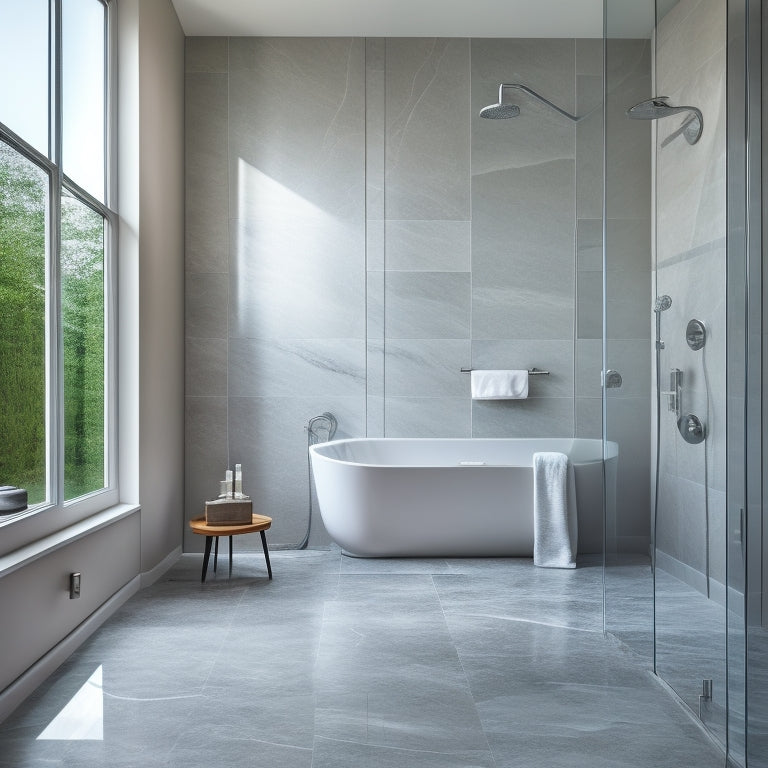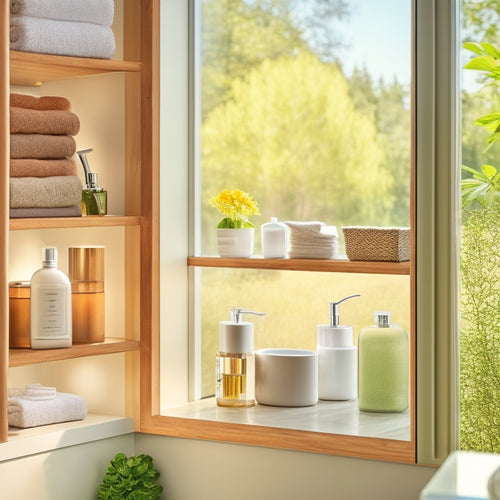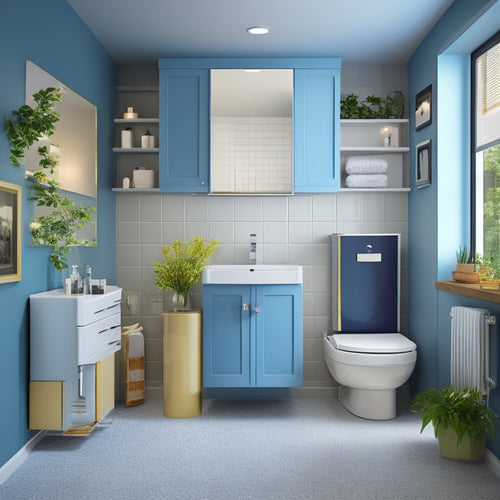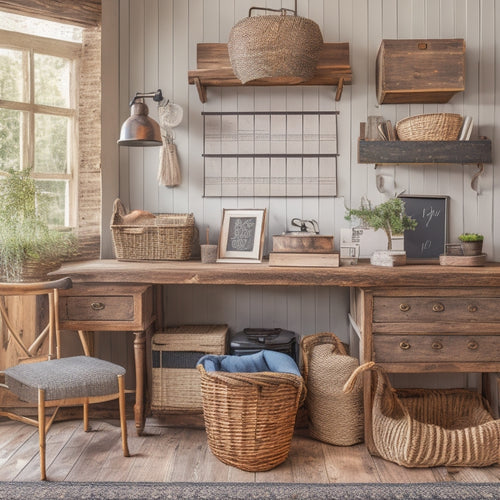
Choosing and Installing Your Freestanding Tub Shower
Share
When choosing and installing a freestanding tub shower, you'll need to take into account factors like style, material, and size, as well as the shower system and head. Measure your bathroom space accurately to guarantee a perfect fit, and map out the "wet zone" for ideal tub and shower placement. Select a shower system that suits your design preferences, such as wall-mount, floor-mount, or ceiling-mount, and choose a shower head that suits your water pressure and desired experience. With a clear plan, you'll be ready to install your tub and shower, and reveal a relaxing oasis that reflects your unique style and needs - and that's just the beginning of your bathroom makeover adventure.
Key Takeaways
- Assess bathroom space accurately, considering obstructions and measuring the "wet zone" for optimal tub and shower placement.
- Choose a freestanding tub that fits your style, material, and size needs, with essential features like jets, LED lighting, and built-in seating.
- Select a shower system that complements your tub, considering wall-mount, floor-mount, and ceiling-mount options, and ensuring compatibility with tub material and water pressure.
- Prepare for installation by reviewing plumbing and electrical requirements, clearing the area, and having necessary tools and materials on hand.
- Ensure proper tub installation by centering the tub, leveling it, connecting plumbing lines, and making aesthetic adjustments for a balanced and harmonious bathroom design.
Understanding Freestanding Tub Options
Your ideal freestanding tub shower begins with a thorough understanding of the tub options available.
You'll want to reflect on the tub styles that fit your design aesthetics, from sleek and modern to classic and ornate. Do you envision a sleek, low-profile tub or a more traditional, raised design? Perhaps you're drawn to the elegance of a slipper tub or the drama of a statement piece with ornate fixtures.
Take note of the materials used, such as acrylic, fiberglass, or solid surface. Each has its own benefits, from durability to ease of maintenance.
You'll also want to contemplate the size and shape of the tub, ensuring it comfortably accommodates your needs. Assess the number of users, desired water depth, and any mobility concerns.
Lastly, think about the features that matter most to you - jets, LED lighting, or a built-in seat.
Measuring Your Bathroom Space
Beyond the perfect tub, a successful freestanding tub shower installation hinges on a precise understanding of your bathroom's spatial constraints.
You'll need to measure your bathroom space to guarantee a harmonious coexistence between your tub, shower, and other fixtures. Start by recording the room's dimensions, including any obstructions like plumbing fixtures, electrical outlets, or windows.
Next, map out your bathroom layout, considering the "wet zone" where the tub and shower will occupy. Measure the distance between walls, as well as the clearance around the tub, to optimize space.
Don't forget to account for any door swings or openings that might impact your design. With these measurements, you'll be able to visualize your ideal layout and make informed decisions about your freestanding tub shower installation.
Selecting the Right Shower System
With precise measurements in hand, you can now focus on selecting the right shower system to complement your freestanding tub. There are three main shower system types to evaluate: wall-mount, floor-mount, and ceiling-mount.
Wall-mount systems are ideal for smaller bathrooms, as they save floor space. Floor-mount systems, on the other hand, offer more flexibility regarding design and are often preferred by homeowners who want a sleek, modern look. Ceiling-mount systems, meanwhile, are perfect for creating a spa-like experience, with water flowing from above.
When selecting a shower system, reflect on the installation tips that will guarantee a smooth and hassle-free process. First, verify that your shower system is compatible with your tub's material and finish.
Next, check the water pressure in your bathroom to determine the recommended flow rate for your showerhead. Finally, think about hiring a professional if you're not comfortable with the installation process, as improper installation can lead to leaks and other issues.
Considering Tub Material and Finish
Freestanding tubs come in a variety of materials, each with its unique characteristics, advantages, and maintenance requirements. You'll find options ranging from acrylic, fiberglass, and solid surface to natural stone, copper, and even wood.
When choosing, consider durability, weight, and, of course, aesthetics. Acrylic tubs, for instance, are lightweight, easy to clean, and budget-friendly, but may scratch or fade over time. Fiberglass tubs are more durable, but can be prone to yellowing. Solid surface tubs, like those made from resin, offer a durable, non-porous surface, but may require more upkeep.
Natural stone tubs exude luxury, but are heavy, expensive, and high-maintenance. Copper tubs add a touch of elegance, but demand regular polishing to prevent oxidation. Wood tubs, a rare find, require careful attention to prevent water damage.
When it comes to finishes, you'll encounter options like glossy, matte, or textured. Glossy finishes shine bright, but show water spots and fingerprints. Matte finishes hide imperfections, but may lack the luxurious feel. Textured finishes add traction, but can be rough on the skin.
Regardless of your choice, remember to follow tub maintenance tips, such as regular cleaning, drying, and sealing to guarantee your tub stays in top condition.
Choosing the Perfect Shower Head
You'll want to take into account the water pressure in your home when selecting a shower head, as it affects the shower's performance and your overall experience.
Look for shower heads with flow rates that match your water pressure - a higher flow rate is ideal for low water pressure, while a lower flow rate is better suited for high water pressure.
Water Pressure Matters
Pressure-balanced shower valves regulate water flow, guaranteeing a consistent shower experience, but it's the shower head that ultimately determines the quality of your daily rinse.
You might be thinking, "What's the big deal about water pressure?" Well, let's tell you - it's a significant factor. Water pressure testing is vital to guaranteeing your shower head performs at its best. A pressure regulator can help stabilize the flow, but you need to choose a shower head that can manage the pressure.
Here are some key aspects to ponder:
-
Water pressure range: Look for shower heads that can handle a range of pressures, from low to high, to guarantee a consistent experience.
-
Flow rate: While we won't explore flow rates just yet, keep in mind that a shower head's flow rate will impact its performance under different water pressures.
-
Shower head design: Some shower heads are designed to thrive under high pressure, while others are better suited for low-pressure systems.
- Water-saving features: If you're looking to conserve water, look for shower heads with built-in water-saving features that won't compromise on performance.
Flow Rate Options
As you traverse the vast terrain of shower head options, the flow rate emerges as a critical factor in determining the perfect shower experience.
You'll want to take into account the gallons per minute (GPM) output, which typically ranges from 1.5 to 8 GPM. For ideal usage, a flow rate between 2.0 and 2.5 GPM is often optimal, providing a satisfying rinse without excessive water waste.
When making flow rate comparisons, take into account your water pressure and shower head style. Rain showerheads, for instance, typically require higher flow rates (around 3-4 GPM) to create that luxurious, drenching experience.
Handheld showerheads, on the other hand, often thrive with lower flow rates (around 1.5-2 GPM) for a more targeted, gentle cleanse.
Don't forget to check your local water regulations, as some areas have restrictions on flow rates.
Preparing for Installation Day
Get set to clear the deck for your freestanding tub shower installation by tackling a few vital tasks beforehand.
You'll want to guarantee a smooth and stress-free experience, so don't skip these essential prep steps.
Before the installation crew arrives, make certain to:
-
Review your plumbing requirements: Take note of the water supply lines, drainage, and any necessary adapters or fittings.
-
Address electrical considerations: Identify the location of outlets, switches, and any other electrical components that may need to be relocated or upgraded.
-
Clear the installation area: Move any furniture, fixtures, or flooring that could get in the way of the installation process.
- Protect your floors: Cover your floors with drop cloths or plastic sheets to prevent damage from water, tools, or heavy equipment.
Installing the Freestanding Tub
You'll need to carefully plan the placement of your freestanding tub to guarantee it's centered and balanced in the room, considering factors like door swing and clearance.
Meanwhile, you'll also need to verify that your flooring can support the weight of the tub, which may require additional structural support or reinforcement.
Once you've addressed these issues, you can focus on securely anchoring the tub to the floor to prevent shifting or movement.
Tub Placement Considerations
The floor's centerline becomes an essential reference point when determining the ideal placement of your freestanding tub, as it serves as a visual anchor for the entire bathroom.
You'll want to balance tub aesthetics with plumbing accessibility, making certain that your tub is both visually stunning and functional.
When deciding where to place your tub, consider the following:
-
Symmetry: Place your tub along the centerline to create a sense of balance and harmony in the bathroom.
-
Plumbing access: Consider the location of your plumbing fixtures and confirm that they're easily accessible for maintenance and repairs.
-
Space constraints: Take into account the size and shape of your bathroom, as well as any obstacles like doors, windows, or corners.
- Personal preference: Think about how you'll use your tub – do you want it near a window for natural light, or in a cozy nook for relaxation?
Proper Flooring Support
With your freestanding tub's placement carefully considered, it's time to focus on the critical aspect of proper flooring support. You can't just plop that beautiful tub on the floor and expect it to stay put; it needs a solid foundation to prevent sagging, cracking, or worse – a catastrophic collapse.
First, assess your flooring type: is it concrete, wood, or something more exotic? Each has its own load capacity, so you'll need to calculate the weight of the tub, water, and occupants (yes, that's you and your partner's combined weight – don't worry, we won't judge).
For example, a solid concrete slab can handle the heaviest of freestanding tubs, while engineered wood flooring may require additional support beams.
Visualize the tub's footprint on your floor plan and identify any weak spots. You may need to reinforce the floor with extra joists or install a tub-specific support system.
Secure Tub Anchoring
Concrete anchors bite into the floor, securing the freestanding tub to the subfloor like a vice grip.
You're not just placing the tub on the floor, you're marrying it to the foundation. This is essential for tub stability, and you don't want any divorce proceedings down the line.
When it comes to anchoring techniques, you've got options:
-
Drill-in anchors: These are like the tub's roots, digging deep into the subfloor for a secure hold.
-
Sleeve anchors: These are like the tub's best friend, providing a snug fit and extra grip.
-
Wedge anchors: These are like the tub's personal trainer, providing extra strength and stability.
- Epoxy anchors: These are like the tub's superpower, bonding with the subfloor for an unbreakable hold.
Final Touches and Accessories
Your freestanding tub shower is taking shape, and it's time to focus on the finer details that enhance its functionality and aesthetic appeal. Now that the tub is securely anchored, you can contemplate adding some tub accessories and aesthetic enhancements to create a spa-like experience.
Here's a breakdown of some essential final touches to contemplate:
| Accessory | Functionality | Aesthetic Appeal |
|---|---|---|
| Rain showerhead | Provides a luxurious shower experience | Adds a touch of modern elegance |
| Body jets | Massages your body for relaxation | Creates a sleek, high-end look |
| LED lighting | Illuminates the shower area for safety | Adds ambiance and visual interest |
| Grab bars | Assists with entering and exiting the tub | Blends seamlessly into the design |
When choosing accessories, consider your personal style, the tub's design, and your budget. Remember, these final touches can make or break the overall look and feel of your freestanding tub shower. So, take your time, and have fun with it!
Frequently Asked Questions
Can I Install a Freestanding Tub in a Small Bathroom?
Yep, you can squeeze a freestanding tub into a small bathroom, but consider space constraints and design aesthetics - measure carefully, opt for a smaller tub, and get creative with layout to avoid a cramped, claustrophobic feel!
Do Freestanding Tubs Require Special Plumbing Installation?
You're probably wondering if your dream tub will require a plumbing ninja to install - and the answer is, yes, freestanding tubs do demand special plumbing installation, which can be tricky, but don't worry, it's doable with the right skill!
Are Freestanding Tubs More Difficult to Clean Than Traditional Tubs?
You'll find freestanding tubs require more TLC than traditional ones, but with the right cleaning techniques and maintenance tips, you'll be a pro in no time, effortlessly tackling those pesky curves and crevices like a boss!
Can I Replace My Existing Tub With a Freestanding Tub?
You're thinking, 'Will I have to gut my entire bathroom?' Relax, you can replace your existing tub with a freestanding one, reaping benefits like more space and elegance, but consider tub size carefully to guarantee a seamless swap.
Do Freestanding Tubs Come With Built-In Grab Bars or Seats?
You're wondering if freestanding tubs come equipped with built-in grab bars or seats for added safety and accessibility. Typically, they don't, but you can always install them separately to guarantee a secure and comfortable bathing experience, enhancing freestanding tub safety and accessibility features.
Conclusion
As you step into your newly changed bathroom, the freestanding tub shower stands as a sleek, modern oasis, a serene escape from the chaos of daily life. The gentle hum of water, the soft glow of LED lights, and the warmth of heated floors envelop you in luxury. In stark contrast, the messy, cramped bathroom of yesterday seems like a distant memory, replaced by a haven of relaxation and rejuvenation, where every moment is a soothing retreat.
Related Posts
-

Modular Storage for Bathroom Decluttering
Modular storage is your solution for effective bathroom decluttering. It maximizes every inch of space, allowing cust...
-

Innovative Bathroom Storage Solutions for Small Bathrooms
You can access a rich repository of storage space in your small bathroom by cleverly leveraging corners, walls, and h...
-

Farm Family's Organized Office: A Detailed Look
I've created a well-organized office space that helps my farm family stay productive and focused. My desk is organize...


